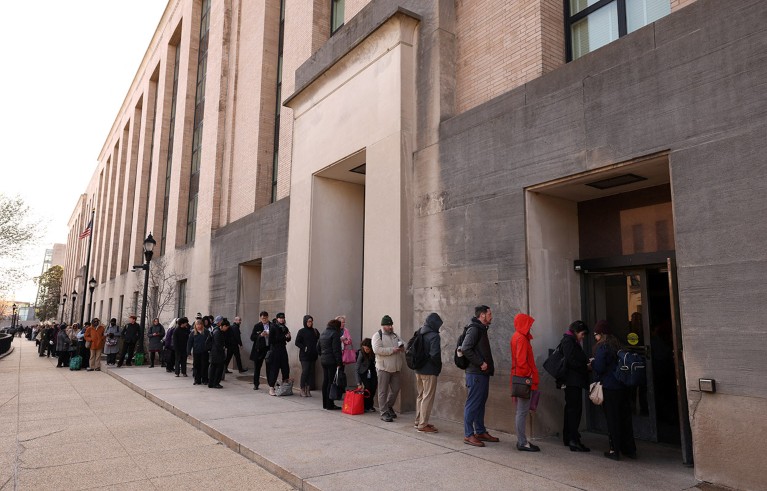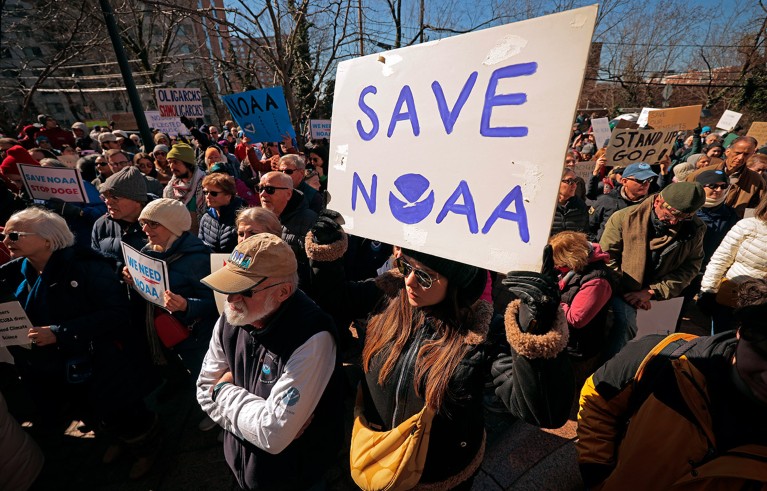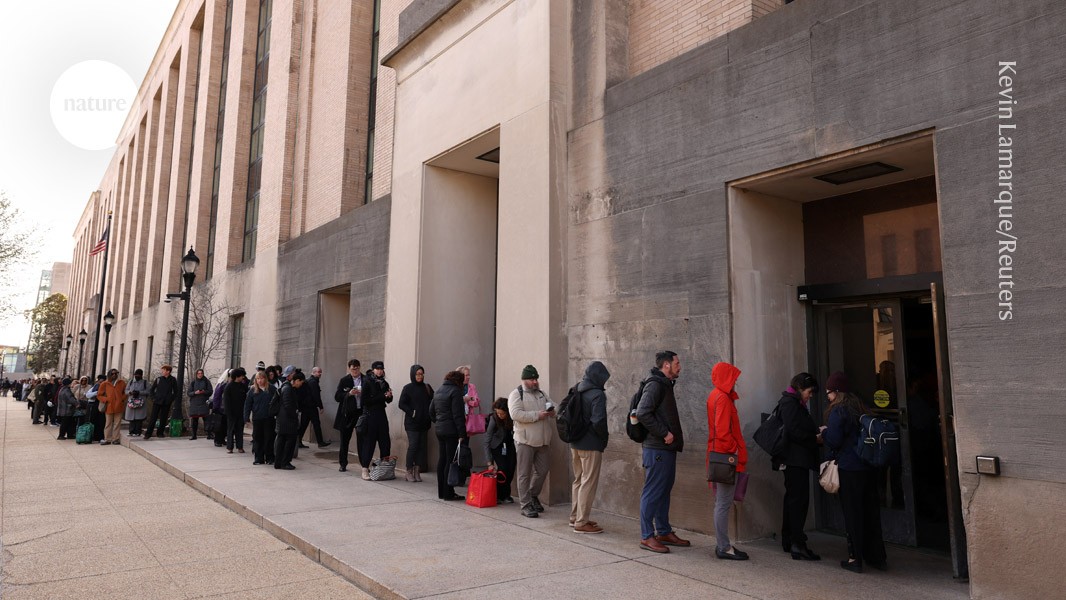
During the week of 1 April, workers at the US Department of Health and Human Services waited in line to access their offices as mass lay-offs began.Credit: Kevin Lamarque/Reuters
As the administration of President Donald Trump continues its campaign to reshape the US government with spending cuts and mass lay-offs, some scientists still employed at government agencies say that their work has become impossible.
The US National Institutes of Health (NIH), a massive biomedical-research funder that also employs thousands of scientists at its own laboratories, is “totally broken and non-functional right now”, according to a principal investigator at the NIH who asked for anonymity because they are not authorized to speak to the press. “We can’t hire people. We can’t recruit people. We can’t talk to people on the outside. We cannot travel,” they say.
How Trump is following Project 2025’s radical roadmap to defund science
Other government scientists, who Nature granted anonymity for similar reasons, say that they can’t afford publication fees or the supplies they need to process lab samples.
At the US National Oceanic and Atmospheric Administration (NOAA) — which monitors Earth’s oceans and atmosphere and provides weather forecasting services — some scientists cannot do fieldwork because many of the contractors they have historically worked with have been furloughed.
Meanwhile, the US Department of Government Efficiency, effectively run by billionaire Elon Musk — a Trump adviser — has been sowing fear among federal workers with its visits to various agencies, threatening possible workforce cuts and more.
Federal science policy “wasn’t perfect”, and some reforms would have been welcomed before Trump took office, the NIH principal investigator says. But now the administration is “tearing everything down … in a way that seems motivated to enrich the people who are doing it, rather than actually making the government work better”, they say.
The White House did not respond to a request for comment. NOAA and the Department of Health and Human Services (HHS), which oversees the NIH, also did not respond.
Short on supplies
In February, the Trump administration began to put a spending limit of US$1.00 on nearly all government credit cards. The effect has been disastrous at science agencies, researchers say. NIH labs haven’t been able to purchase essential items: gloves, pipettes, paper towels, Petri dishes, reagents, fluorescent dyes and storage vials. One lab has run out of a chemical needed to freeze brains from organ donors for storage and processing. The news website STAT reported last week that some purchasing restrictions will be lifted at the NIH, but the HHS did not respond to Nature’s request to confirm the change.
Clinical trials run by the NIH have been affected, too. One agency lab that analyses blood samples for more than 200 trials — studying cancer treatments, organ transplants and more — lost half of its staff during lay-offs. On busy days, the lab’s workers cannot process samples quickly enough and must borrow colleagues from other groups to help, a lab member says.

Demonstrators protested over the firing of probationary workers at the US National Oceanic and Atmospheric Administration in Silver Spring, Maryland, in March.Credit: Chip Somodevilla/Getty
The researcher was fired in February as part of an initial sweep of probationary workers — those who have usually been in their positions for less than two years — following directives from the US Office of Personnel and Management (OPM). When a federal judge blocked the firings later that month, saying that the OPM did “not have any authority whatsoever” to do so, probationary staff members were ‘reinstated’, but instead of being allowed to return, some were placed on administrative leave. “I want nothing more than to just be able to go back and do my job,” the researcher says. Although they are happy to be paid again, “I feel kind of helpless sitting here,” they say. “It does feel like, ‘Oh, this is ironic’, that this is actually a waste of taxpayer money”, given the cuts have been justified on the grounds of government efficiency, they add.
The US Supreme Court halted the order to reinstate probationary workers on 8 April. It’s unclear what will happen to the NIH researcher, but NOAA moved last week to fire its reinstated probationary workers — this time, presumably, for good.
Some NOAA workers had already decided that they couldn’t just sit around. Fearing that they would be laid off, one probationary scientist who was fired and then rehired, only to be placed on administrative leave, downloaded work files to their personal computer in late February. They spent several weeks analysing data with former colleagues while awaiting word regarding their employment status. “I’m just doing my research,” the scientist told Nature before they were fired the second time. Their response when asked whether it was legal to work while on administrative leave: “I’m not entirely sure. I’m not a lawyer.”
Off-mission work
Some federal scientists say that the government seems to be deliberately trying to make their work harder. “We are constantly barraged with enormous amounts of, let me be frank, bullshit administrative work,” says an NIH researcher. They say that Trump team officials send requests — such as gathering a list of all contract employees — alongside ultimatums that suggest employees will be fired if they fail to respond within 24 hours. The stream of demands is “strangling many aspects of the function of NIH with red tape”, they say.



